After a nervy final 10 minutes, celebrations began for Jesse Marsch’s Red Bulls as they lifted the second Supporters’ Shield in their history. From being on top for the opening 45, the momentum of the game gradually shifted in the second half and Chicago came close on a number of occasions as they managed to bring one back through Gilberto.
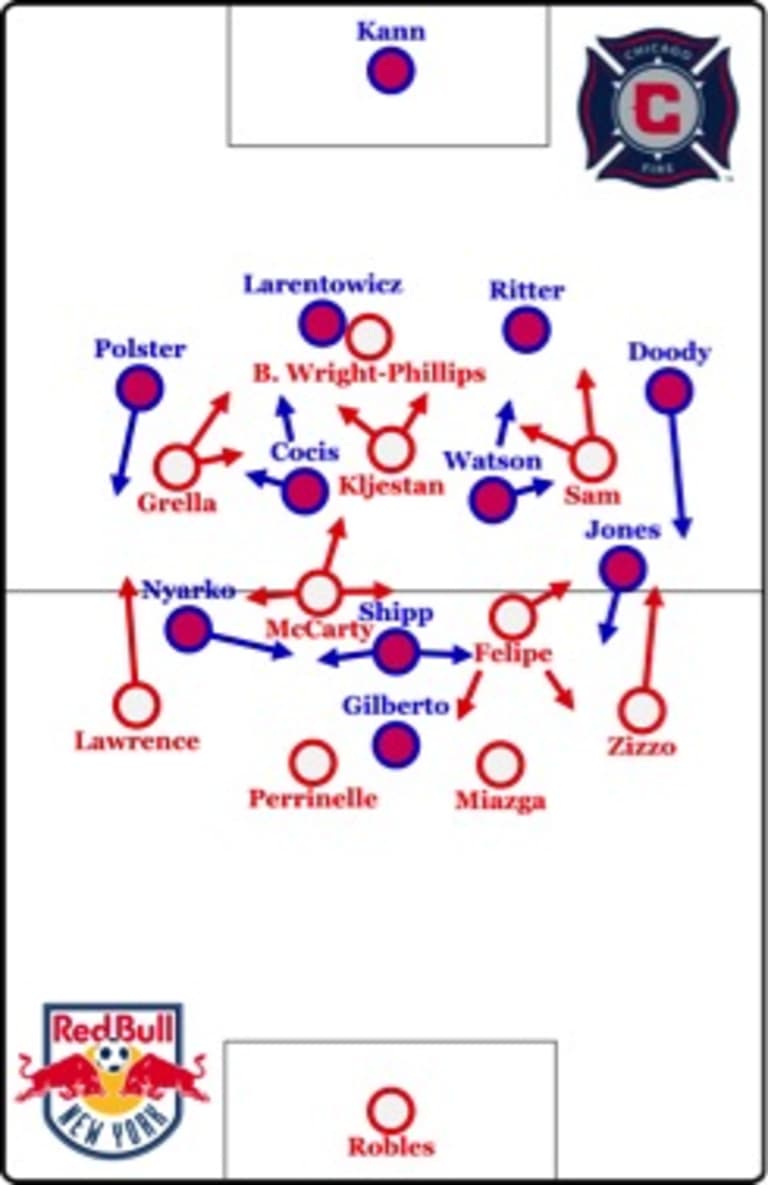
For the final game of the regular season, Marsch lined his team up in the standard 4-2-3-1 formation. Robles was the goalkeeper with Miazga and Perrinelle in-front of him while Lawrence and Zizzo took to the full-back positions. The rest of the squad was unchanged from their dominant win against Philadelphia.
After losing heavily to D.C. United, Chicago fielded a much-rotated squad from their last showing. Six of the 11 players who started against D.C. didn’t make it in the starting eleven for the final game of the regular season. Across the 4-2-3-1 formation, the only partnership which remained was that of Harry Shipp and Gilberto in the center of the attack.
These changes in personnel seemingly had a positive influence on their performance, as the deficiencies seen in their loss to D.C. were improved on Sunday evening. Despite losing again, their performance was better and it took some strong pressing from the likes of Dax McCarty and Sacha Kljestan (see the trap below) to reduce their ability to break into the 10 space.
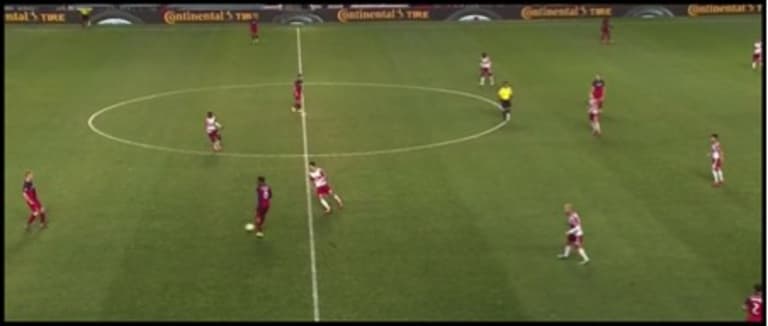
An Attacking Start
Marsch’s team have become well-known for threatening during the opening stages of games and are among the top scorers in the league for goals in the first 15 minutes. They showed a similar impetus to the Philadelphia game as they made an aggressive start away from home.
During their build-up, they were slightly more direct than usual as Matt Miazga and Damien Perrinelle looked to get the ball to Wright-Phillips and co. very quickly, at times bypassing the duo of McCarty and Felipe. They may have been looking to take advantage of the uncompact press from Chicago.

Against D.C., Chicago were particularly uncompact when pressing the ball upfield. Take the above scene for example – there are significantly big spaces between the lines of players as the D.C. center back plays an accurate long ball into the yellow area.
McCarty himself could be seen taking aggressive positions in the opening 10 as opposed to his usual role of supporting alongside Felipe.
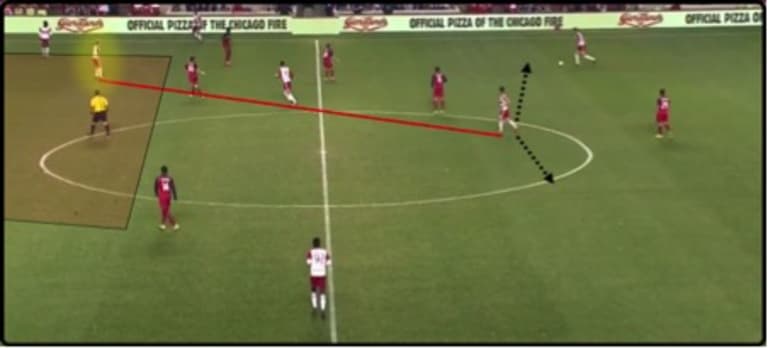
In doing so, he offered an extra body between the lines to receive long and vertical passes. From these he would help in a number of ways, from offering in combinations if the pass was successful to aiding the potential counter-press if Chicago intercepted the first ball.
This structure was quite open for the defensive transition where Chicago had the opportunity to counter-attack which is probably why we don’t see it more often. The aggressive nature of the Red Bulls’ start was ultimately a good decision, as Wright-Phillips scored another goal from a corner kick.

Improved Build-up for Chicago yet Lacking in Third Phase
One of the most telling differences between the performances versus D.C. and against the Red Bulls was their build-up play. Against RBNY, Chicago were much more ball-oriented in their positioning when bringing the ball out from defense.
Against D.C., an issue which they had was that the midfield offered little support for the center backs to move the ball upfield with short passes.
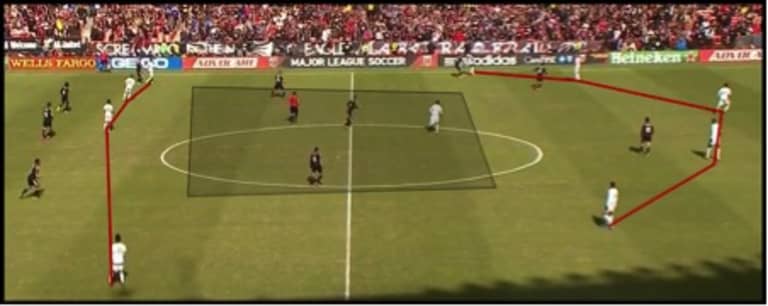
One example (see above) was when there’s only one Chicago player in the center of the pitch. Although one center midfielder had dropped to offer for a pass, he does so in a position which provides no benefit and will not progress the ball.
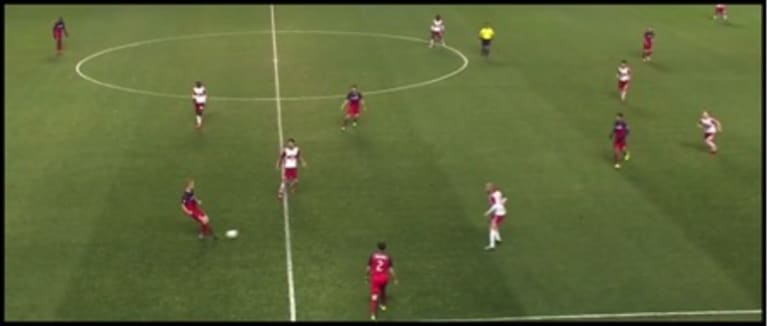
However against the Red Bulls, they had more players dropping deep to offer themselves for a pass in the first phase of possession. This meant that through the increased number of connections, the ball carrier had more options on the ball (thus not becoming isolated) while the structure occupied the space around the ball much better.
By having a more effective building game, Chicago benefited in midfield when preparing to break the RBNY lines. This is reminiscent of the teachings of Juan Manuel Lillo, a renowned Spanish coach known for tutoring soccer greats like Pep Guardiola, who once said, “Everything is much easier when the first progression of the ball is clean.” This first moment of possession proved vital for Chicago.
When D.C. played Chicago, United did not press with great intensity, although the possession game of the Fire still struggled. Therefore, one can assume that superior connections against RBNY would be necessary for Chicago’s success, considering the pressing machine which Marsch has developed.
Because of the bigger focus on supporting around the ball during the build-up, there were a few cases where Chicago didn’t have a great presence when looking to create chances in the final third. This was particularly on quick attacks where the players who initially dropped were slow in moving up the pitch. It was only during the second half when they found a good balance between the two, as they had to be more aggressive in chasing the game.
During this stage through the second half, Chicago were at their most dangerous as they had a strong building game, but also a competent structure in midfield and attack too. Their combinations across the front four were strong and they started creating a few chances before eventually pulling one back.
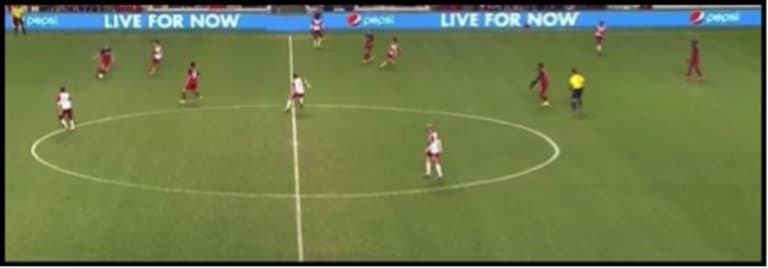
Second Half Momentum Shift
Chicago’s strong build-up game and combinations across the front four was the main cause for the momentum shift through the second half which nearly saw Chicago equalize in the late stages of the match. Some psychological aspects could’ve influenced the match too, such as nerves as Marsch’s men moved closer to the club’s second shield.
A few minutes after Gilberto’s goal, Marsch was quick to change the structure. He substituted goal scorer Bradley Wright-Phillips for Ronald Zubar. The defender moved into center back and a 5-4-1 shape was formed as Gonzalo Veron took on the role of striker. Kljestan moved to right midfield with Shaun Wright-Phillips on the opposite flank.
With a more defensive structure, the defensive strategy and tactics changed too, with them moving to a mid-low block which didn’t press as frequently in Chicago’s half. The pressure was more focused on spaces around the midfield, which they looked to protect with increased urgency.
The attacking strategy became more oriented around counter-attacks from deep as opposed to those when the ball is regained higher up the pitch as Chicago pressed for a second goal. Through some stable and controlled defending, the Red Bulls got over the line to clinch the Supporters’ Shield.
Throughout the regular season, Marsch and his team have played some of the best soccer in terms of effectiveness as well as from an aesthetic perspective. The focus now turns to the Audi 2015 MLS Cup Playoffs where the club will push for the MLS Cup.




